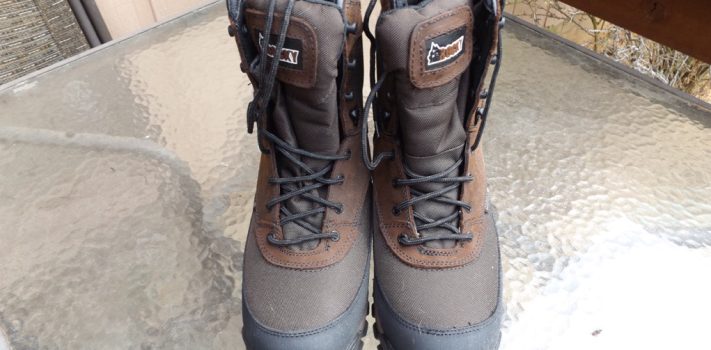If your hands and feet get cold, the rest of your body isn’t far behind. This is a fact! Going back to my high school days, I attended a private Lutheran High School, and it was about 13-miles from where I lived – that is a long, long distance in a big city (Chicago) to travel. On a good day, it would take me about an hour and a half to get to school, and home at the end of the day, on the CTA (Chicago Transit Authority) bus. As most big-city dwellers will know, buses usually make a stop about every other block, if someone is standing at a bus stop sign.
During the warmer months, there wasn’t any air conditioning on the buses back then. And in the winter months, and the heaters didn’t work very well at all – except near the front of the bus where the drivers sat. More often than not, during the winter, especially if there was fresh snow on the ground, the buses almost always ran 15-minutes late – ugh! Chicago isn’t called the Windy City, for nothing. During the Winter months, the wind really kicks up, and if you are standing on a street corner, waiting on a bus, then you got cold – just that simple. I usually wore my high school jacket – it looked cool, but it wasn’t warm once the wind started blowing. Add some blowing or falling snow into the mix, and you got cold, very cold.
Back in the day – circa the mid-1960s to late-1960s, there weren’t any such thing as insulated boots – just wasn’t any such thing outside of miitary “Mickey Mouse” boots. So, leather shoes were the uniform of the day, and they were not – and still are not – very warm to wear in winter months. Back then, if your shoes happened to get wet, then you were all that much more miserable. In 1969, Gore-Tex was invented. However it wasn’t very well known back then, and it was pretty expensive. Add in some light-weight insulation to waterproofed clothing, and it was a miracle, and you stayed warm and dry.
I’ve been wearing insulated and waterproof boots for about 35+ years now – during the winter months, and they keep my feel warm and dry. This is important since I have Type 2 Diabetes. You have to keep your feet warm and dry so, you have good circulation in your feet. If you don’t, then you can easily lose some toes, or even your feet if the blood isn’t circulating down to your feet. We live in Western Oregon these days – going on our 16th year, and as a rule, we don’t get a lot of snow or a lot of very cold days. However, when it does get down below freezing, I reach for a pair of waterproof and insulated winter boots. My gloves are also insulated. You can’t be too careful when you have Diabetes 2.
As a rule, I wear waterproof hikers most of the year, however at times, I will reach for a pair of hikers or athletic shoes that aren’t waterproof – especially in the hot Summer months. I’ve experimented with several brands of insulated/waterproof boots over the years, and I’ve found that the ones made by Rocky, to be about the best. I’ve owned several different pair over the years. One pair, I had resoled twice – unfortunately, the second time around, the boots squeaked – a lot when I walked. I finally gave that pair away.
Now, save your hate mail: I’ve done a lot of research, and found out that about 80% – 95% of our footwear is made in China. Sad to say, when we go to war with China – and it will happen – if we don’t win right away, many of us will be barefoot ‘cause there won’t be much more footwear coming into the USA. I know, I know, none of us like “contributing” to the Red Chinese economy, but it can’t be avoided. One of the best boot makers in the USA happens to be Danner, right here in Portland, Oregon. Their top of the line boots are still made here in the States. However, the majority of their boots are now made in mainland China. That had to happen – everyone else is doing it, and in order to compete in today’s market, “you have to do what you have to do”, to stay in business.
My current pair of Rocky boots are made in mainland China – unfortunately, they are not resoleable. When the soles wear out, you have to toss them in the trash. Not a good thing when you paid $150 to $250 for those boots. These boots do not have a make or model number, so I don’t know what to call them – but if you look at the Rocky website, and want a similar pair, you will find them.
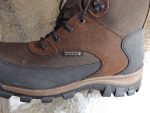 Some stats on these Rocky boots – they are 9-inches tall – so they will keep water and snow out of them – most of the time. They have 800-grams of Thinsulate Ultra insulation. This is some of the thinnest insulation you can find, yet it will keep your feet nice and warm in winter months. I’ve had other Rocky boots that I wore in -20 degrees temps and my feet never got the least bit cold. The uppers are made out of 900 Denier Nylon, this is some tough stuff, and can take a beating. I’ve never had 900 Denier Nylon rip. The lower is black rubber to help prevent scuffing or tearing – it covers the lower half of the boot around to the arch, and then a little break, and it covers the heel.
Some stats on these Rocky boots – they are 9-inches tall – so they will keep water and snow out of them – most of the time. They have 800-grams of Thinsulate Ultra insulation. This is some of the thinnest insulation you can find, yet it will keep your feet nice and warm in winter months. I’ve had other Rocky boots that I wore in -20 degrees temps and my feet never got the least bit cold. The uppers are made out of 900 Denier Nylon, this is some tough stuff, and can take a beating. I’ve never had 900 Denier Nylon rip. The lower is black rubber to help prevent scuffing or tearing – it covers the lower half of the boot around to the arch, and then a little break, and it covers the heel.
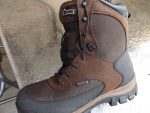 The waterproofing is simply one by Rocky – and they perfected it – it is just as good as the original Gore-Tex waterproofing. The top of the boot has soft leather around it, so it is very comfortable when the boots are laced-up. There are 8 lacing holes – well, the top 4 are of the speed-lacing type – very much appreciated since you don’t have to spend a lot of time lacing the boots back up after you take them off. The bootlace is black, and it is rounded – makes for fast on/off and these laces are tough – unlike some flat-style laces. There is also a padded insole for comfort. I wear prescription insoles because I have high arches, and I simply place them on top of the factory padded insole. That works great.
The waterproofing is simply one by Rocky – and they perfected it – it is just as good as the original Gore-Tex waterproofing. The top of the boot has soft leather around it, so it is very comfortable when the boots are laced-up. There are 8 lacing holes – well, the top 4 are of the speed-lacing type – very much appreciated since you don’t have to spend a lot of time lacing the boots back up after you take them off. The bootlace is black, and it is rounded – makes for fast on/off and these laces are tough – unlike some flat-style laces. There is also a padded insole for comfort. I wear prescription insoles because I have high arches, and I simply place them on top of the factory padded insole. That works great.
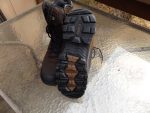 Now, to the sole of the boot, it is very aggressive and heavily “lugged” and it simply has the word “Rocky” on them. These should give you a lot of years – literally – a lot of years of wear, before they wear down to the point when you have to replace the boots. We also have a pull-on tab on the top rear of the boot – this helps in pulling the boots on. The tongue is almost fully gusseted – so debris doesn’t get into the boots. The last inch on the top, is not fully gusseted. I’ve had other no-name boots, and the tongue wasn’t gusseted at all – that meant that junk, water, and snow could get into the boots – not a good thing.
Now, to the sole of the boot, it is very aggressive and heavily “lugged” and it simply has the word “Rocky” on them. These should give you a lot of years – literally – a lot of years of wear, before they wear down to the point when you have to replace the boots. We also have a pull-on tab on the top rear of the boot – this helps in pulling the boots on. The tongue is almost fully gusseted – so debris doesn’t get into the boots. The last inch on the top, is not fully gusseted. I’ve had other no-name boots, and the tongue wasn’t gusseted at all – that meant that junk, water, and snow could get into the boots – not a good thing.
A word or two on insulation – we are all different, and react to cold temps in different ways. So, just because my feet have never gotten cold or even chilled in a pair of boots with 800-grams of Thinsulate Ultra insulation, doesn’t mean, your feet may not get cold. I almost always wear a thick pair of wool socks when I’m wearing waterproof/insulated boots. It just adds another layer of warmth. At times, I’ll wear a pair of USGI wool socks – they aren’t 100% wool, but do a good job just the same.
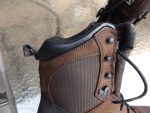 I might suggest that, if you wear thick, heavy socks, that you order these boots about half a size bigger than your normal foot size. If you’re into survival, especially in the winter months, where you will face extreme cold and snow, then you need these boots – or something similar – if you plan on surviving the harsh elements. Add in a good waterproof/insulated winter parka, and some great gloves or mittens, and you’re good to go. I know, goosedown insulated parkas will keep you warmer, but once they get wet, you lose your insulation properties – not good. Plus, goose down parkas are big and bulky, and modern parkas that are insulated with Thinsulate or a similar material are lightweight and not very bulky and will keep you warm – even if you take tumble into some water. I have one Winter parka, that has 300-grams of “Thermoloft” a man-made that is similar to Thinsulate…and I’ve never once had to zip it up – it has kept me warm in temps well below zero.
I might suggest that, if you wear thick, heavy socks, that you order these boots about half a size bigger than your normal foot size. If you’re into survival, especially in the winter months, where you will face extreme cold and snow, then you need these boots – or something similar – if you plan on surviving the harsh elements. Add in a good waterproof/insulated winter parka, and some great gloves or mittens, and you’re good to go. I know, goosedown insulated parkas will keep you warmer, but once they get wet, you lose your insulation properties – not good. Plus, goose down parkas are big and bulky, and modern parkas that are insulated with Thinsulate or a similar material are lightweight and not very bulky and will keep you warm – even if you take tumble into some water. I have one Winter parka, that has 300-grams of “Thermoloft” a man-made that is similar to Thinsulate…and I’ve never once had to zip it up – it has kept me warm in temps well below zero.
There’s a lot to Winter survival, especially when it is cold to the extreme…you have to have the proper clothing, footwear, socks, gloves, and a head covering, if you expect to survive the elements. All I know is that when my hands and feet get cold, the rest of my body will follow. And once you start shivering, it takes a miracle to get warm again.
Shop around for your next pair of boots – with Winter survival in mind. It is hard to go wrong with those from Rocky or Danner – they make some of the toughest and best waterproof and insulated boots you can find. It is one thing to spend the day hunting in cold weather, but it’s another thing if you might get stuck living in Winter conditions.

